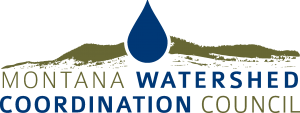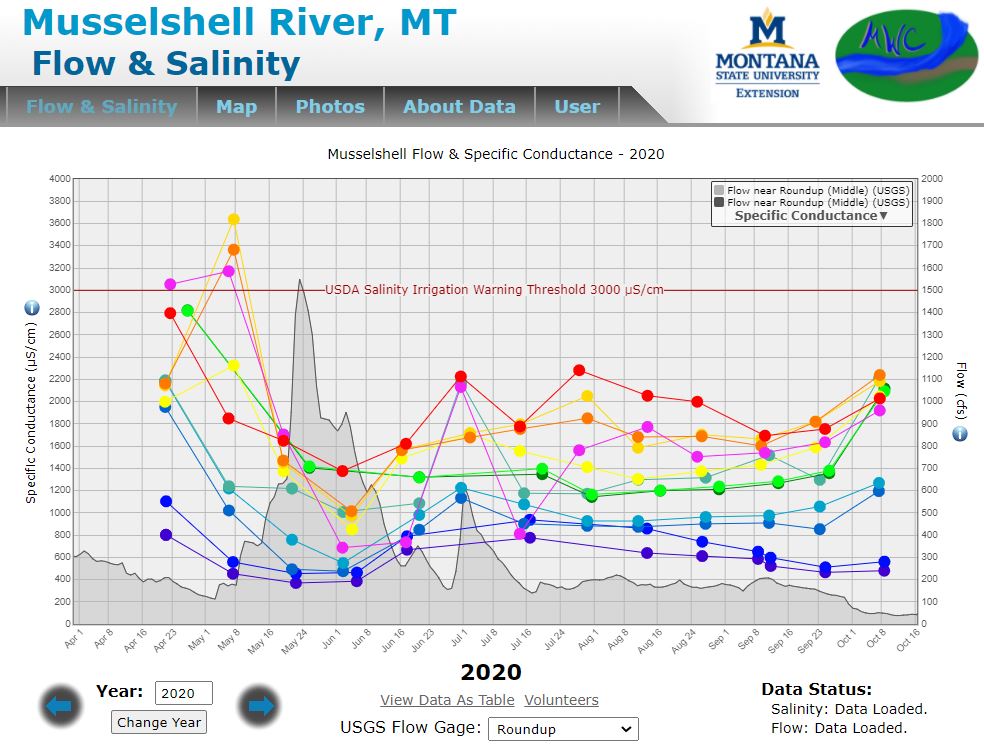Volunteer Monitoring Programs and Resources
Adam Sigler and Claire Bickford, MSU Extension Water Quality. Adam Sigler is also Chair of the MWCC Water Committee
In response to irrigator concerns about saline water reducing crop productivity, the Musselshell Watershed Coalition (MWC) has been collecting river salinity data for seven straight years. The five volunteers who collect the data are spread out from Harlowton to Mosby and cover far in excess of 200 river miles. The data they’ve gathered, which are viewable alongside USGS flow data through the MSU Extension Water Quality (MSUEWQ) Data Hub, clearly show that salinity increases moving downstream and salt concentrations are highest when flows are lowest.
MWC’s volunteer monitoring program is one of many across Montana that are collecting data to better understand specific local concerns about water quality and quantity and to engage the public in working toward solutions.
Volunteer Monitoring Resources
The Montana Dept. of Environmental Quality (MDEQ), Montana Watershed Coordination Council (MWCC), and MSUEWQ have been partnering to provide technical assistance to volunteer monitoring groups for over 10 years. MDEQ provides lab analysis funding each year as well as technical guidance on their website, MWCC has a who’s who in water monitoring website and has coordinated many trainings, and MSUEWQ has a variety of resources in addition to the Data Hub.
In February of 2020, Katie Makarowski (MDEQ) and Adam Sigler (MSUEWQ) led a volunteer monitoring workshop in Helena attended by 23 attendees from 19 organizations. The workshop focused on helping volunteer monitoring groups refine their programming to meet their goals. The Monitoring Methods Selection Guide and the Volunteer Monitoring Catalogue were two primary resources from the workshop, which are available through the MDEQ and MSUEWQ websites.
Volunteer monitoring of Montana’s water resources has been going on for more than 20 years, and the number of programs has been steadily increasing in recent years.
More About Local Monitoring Efforts
The Sun River Watershed Group (SRWG) has collected an impressive dataset for nutrients spanning 20 years, which facilitated a nutrient trend analysis in 2017. These data indicate that certain tributaries contribute more nitrogen to the Sun River than others and that nitrate moving through groundwater is an important nitrogen source to the river. This volunteer-collected data has helped the SRWG identify project opportunities and continues to help inform their strategic plans moving forward.
Data from the Madison and Gallatin stream teams are also viewable in the MSUEWQ Data Hub, with more groups on track to add data soon.
In the Musselshell, the MWC recently expanded its volunteer monitoring efforts to again address local concerns. Many small streams and springs in central and eastern Montana have salt and/or sulfate concentrations too high for livestock, so in 2020, Big Sky Watershed Corps member Brian Hauschild added a project on livestock water. Brian monitored stock ponds in Petroleum County and found salinity concentrations increased by an average of 27% over the summer, an important consideration for livestock producers trying to make sure their animals have safe water to drink. (Brian’s report and poster are available here.)


